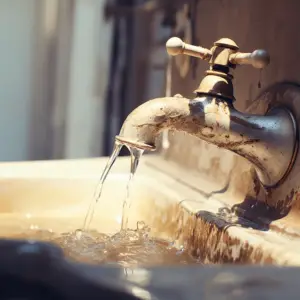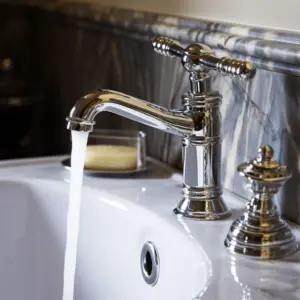Faucet leaks, You’ve probably heard the sound of a leaky faucet. It’s not just annoying, it’s wasteful.
Leaking faucets are one of the most common problems related to plumbing. While it is not a major cause for concern, you shouldn’t ignore it either. On average, about 2500 gallons of water is wasted in every home because of leaking faucets a year.
While it may not seem like a lot, it can make a huge difference in your water bills and in the environment. The first thing you should do if you notice that your faucet is leaking is to try to locate the leak.
Table of Contents
Faucet Leaks Underneath When Turned On

If water leaks underneath a faucet when turned on, either the inner cartridge has worn out or its seal has been damaged. To repair this leak, you should first turn off the water supply and remove the faucet spout. Next, replace the inner cartridge—this will require a tool like a cartridge puller or an Allen wrench. You’ll also need to replace any O-rings that may be worn out or damaged. Finally, double-check for leaks by turning on the water again under pressure and looking for signs of leakage in various spots underneath and around the sink base.
Minor leaks in your faucets and drains can cause stains, increase water bills, and attract mold, which can be a safety hazard. In order to properly seal the sink, you may have to caulk underneath it where the leak occurs. This is why finding the exact cause of the problem and sealing leaks quickly is so important.
But in most cases, fixing the inner workings of your faucet should be enough to fix leaks. Still, locating the leak is the first step in fixing it.
Keep reading to delve deeper into the causes of leaks and how to fix them.
What Causes the Faucet to Leak?
If you have an older home, there is a chance that you are experiencing leaks. The first step in diagnosing a leaky faucet is to determine what causes the faucet to leak.
Faucet leaks can be caused by several factors. If your leak is coming from underneath the sink when turned on, it may be due to one of the following causes:
- A faulty cartridge inside the faucet
- A loose nut or screw on the handle or spout
- A hole in the pipe leading to or from the faucet
- Corroded connections
- A bad seal between two pieces of metal
Detecting a faucet leak may take some time, but it’s important to know the signs of a leaky faucet so you can address it before serious damage occurs.
Dripping or trickling water is often the first sign of a problem with your faucet. If you hear this sound coming from one of your sinks or tubs, immediately inspect the area for any signs of damage. If there are no visible signs of damage and the sound continues, call a plumber for help.
A loose handle on a sink faucet is another sign that it’s leaking underneath when turned on. Also, water spots under the sink or tub can be an indication of a leak.
When a faucet leaks, it’s usually because of wear and tear or internal damage. A slow leak can lead to more serious problems, such as mold growth and structural damage to your home.
How to Fix a Leaky Faucet
You can repair most minor leaks with a few basic tools and supplies.
You’ll need:
- An Allen wrench
- A screwdriver, and
- pliers
Here’s how to go about it:
Turn Off the Water
Before you start any work on your faucet, make sure you turn off the water supply to your sink. If you don’t, you risk damaging your pipes or flooding your bathroom.
Clean or Replace a Damaged Cartridge
If you are experiencing leaking from underneath and it is a faucet that has a cartridge, it could be that the cartridge needs to be replaced.
You can check this by simply turning off the water and removing the handle. The cartridge is held in with two nuts on either side of the spout.
Use an Allen wrench to remove these nuts, and then pull out the old cartridge. Insert a new one by putting it in place, securing it with both nuts, and then turning on the water again.
Cleaning your inner cartridge regularly is important to ensure that it never stops working or causes leaks. If the leak has already occurred, you should consider replacing your faucet cartridge.
Replace Worn Out O-rings
O-rings are rubber rings that put pressure against parts of your faucet to prevent leaks and keep them working smoothly.
If your leaking faucet has one but isn’t working properly any longer because it’s worn out, you’ll need to replace it with a new one before trying anything else. This can be done by removing your faucet handle and looking for the small black O-ring inside there (it should look like an “O” shape).
You’ll need to take out this old O-ring and replace it with a new one before going further with repairs or replacing other parts of your faucet altogether.
Check for Loose Connections

Check all of the connections between the parts of your faucet that move and pivot. Make sure they are tight enough so that they won’t move when water pressure is applied.
Also, check for any leaks around these connections. If there’s a leak here, tighten any loose connections until they stop leaking.
Conclusion
Faucets are supposed to be watertight, but if you have a leaky faucet, it can be frustrating. Most leaks are caused by worn-out cartridges, seals, or O-rings, which can be replaced. Cleaning these parts is a good way to get your faucet working again, but it’s important to make sure there aren’t any other problems before you replace these parts.
If you are unsure of which component is causing the leak, you should hire a professional plumber to inspect your faucet.
If you have older fixtures or pipes, you may need to replace the entire faucet instead of just replacing parts.
